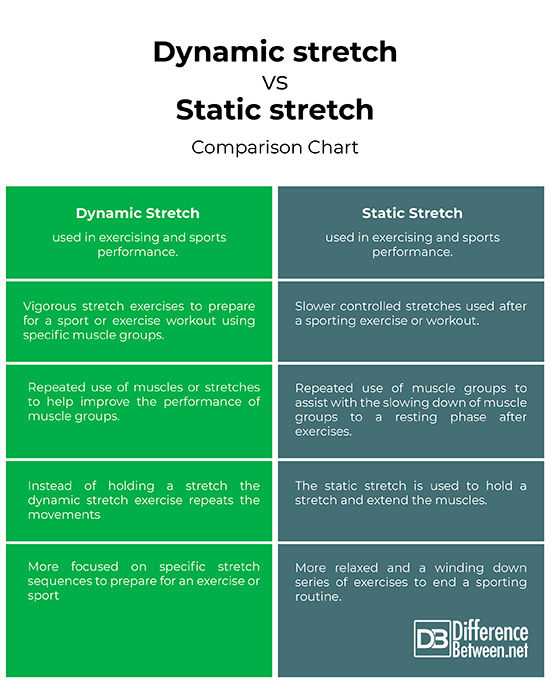Difference Between Dynamic Stretching and Static Stretching
Stretching is a vital part of physical fitness and sports training. The stretch is such an important part it is classified into tow different stretch groups. A dynamic stretch and a static stretch. Although both these terms refer to stretching exercises they are used differently for different reasons and at different times in training for spots events. The dynamic stretch is more vigorous and physically engaging. The static stretch is a slower more relaxed form of stretching. It is the dynamic stretch that is used to warm up and the static stretch is used to cool down at the end of the exercise. Dynamic stretches focus on the activity that is planned and works the relevant muscle groups. The static stretch will help muscles cool down and return to their resting state. Both these stretches are important to the athlete and although they both stretch muscles they have different roles to play in the exercise routine. The essential difference between the two is how the exercise is performed and when it takes place.
What are Dynamic Stretch exercises?
Dynamic stretch exercises are more vigorous than static exercises. When dynamic exercises are performed the stretch is not held. A range of movements are performed moving the action through a range of stretch exercises. The dynamic exercises imitate the activity to be performed prior to a particular sport. Dynamic stretch exercises would go through a series of lunges, and arm swings,. These could be the desired exercises to help a butterfly swimmer. Dynamic stretches target the joints and muscle groups of that particular routine. The best time for a dynamic stretch is before the training or sport begins. They are included in the warm-up because they increase blood flow and mobility. They mimic the activity that is planned to focus on the muscle groups required.
What are the sporting benefits of Dynamic Stretches?
- Dynamic stretching warms up the athlete and increases blood flow and mobility.
- Dynamic stretches closely imitate the activity to be performed and use similar muscle groups and actions in the warm up. This leads positively into the next stage of performance and participation in the particular sport.
- The dynamic stretch covers a range of movements and uses a number of muscle groups. It is more vigorous and uses several muscle groups in the course of the warm up.
- Dynamic stretches are a pre workout enhancer and specific muscle groups are used to target the key performance areas.
What are Static Stretch exercises?
Static stretch exercises are slower and more controlled forms of exercise. Static exercises are used to hold a pose in a stretch position and are suited to the post workout stage. They help with the cooling down process as they relieve muscle tension. Static stretches loosen the muscles and decrease the possibility of delayed muscle soreness. Static stretches can also be used during non-exercise times as they help increase flexibility. Hamstring stretch, quad stretch and head bends are all examples of static stretches. Recent studies have shown that static stretches, prior to a workout, can inhibit the work out performance. During the static stretch the body is able wind down to a resting mode and the heart rate can slow down to a normal pace. In view of the fact that these stretches facilitate resting it is clear that they belong after the vigurous exercising is complete.
What are the sporting benefits of static stretch exercises?
- Static stretches are good post activity exercises.
- They loosen tense muscles and help the body to relax and the heart rate to slow down after a strenuous excerise routine.
- Static stretches are useful at anytime for flexibility and muscle tone, but serve a very important purpose after an exercise routine is complete.
- They are best after a sport for cooling down and resting the muscles.
Dynamic Stretching Vs. Static Stretching
-
Pre-activity exercising:
It is important to prepare the body for strenuous exercise or a sporting activity. In the pre activity area of exercises the dynamic stretch is the exercise recommended to prepare for a sport or exercise workout. These exercises get the right muscle groups ready for top performance and by using the right exercises to stimulate the muscles needed. In this way an athlete can improve his performance and at the same time take care of the specific muscle groups used in the exercise routine.
-
Post activity exercising:
It is equally important to finish exercising with some form of static exercise that will help with the cooling down and relaxing stage of the muscular activity. Static stretching fills this role and assists with returning the heart rate to normal and the muscles to their relaxed state This is an essential part of ending the exercise workout or the sport activity. The post activity exercises are a vital part of the routine and help prevent cramping and muscle damage due to poor resting time after exercising.
-
Differences in the application of the exercises.
The difference is noticed in the how and the when part of understanding the activity. How refers to the speed at which the exercise is performed and when is the pre or post exercise time for the stretch to be most advantageous.
-
Muscle tone and performance benefits.
Both static and dynamic exercises enhance muscle tone and performance. The dynamic stretch, with the pre exercise timing, is the stretch to prepare the muscle groups needed for the performance of the sport or exercise workout. The static stretches assist with the resting the muscles and returning them to a relaxed state preventing delayed muscle soreness. These stretches suit the end of a routine best because they allow muscle froups to take time to relax and return to their normal state after a workout.
Dynamic stretch vs Static stretch: Comparison Chart
Summary of Dynamic Vs. Static Stretching:
- Stretching is an important aspect of sport and physical exercise. Knowing when and how to stretch for the best outcome could make the difference to an athletes performance.
- Dynamic stretching as the name suggests is vigorous and performed before the sport or the workout begins. Static stretching is the follow up at the end to help the athlete cool down and return to his resting phase. Both these exercises contribute to an improved performance.
- Static stretching is a slower more controlled series of exercises to assist with the returning to resting phase. The static stretches compliment the dynamic stretches when they are part of the whole routine.
- The experienced athlete or trainer will target the right muscle groups the athlete will use during the workout or sports game. The purpose of the dynamic stretch routine will be to get those muscles needed flexible and warmed up ready to exercise. The static stretches will be there to help return to a resting phases and cool the muscles.
- Difference Between Lagoon and Bay - October 20, 2021
- Difference Between Futurism and Preterism - August 12, 2021
- Difference Between Dichotomy and Paradox - August 7, 2021
Search DifferenceBetween.net :
Leave a Response
References :
[0]Howard M Michelle. Sept 11th 2017 What is the Major difference between Static and Dynamic stretching? www.livestrong.com/article/44725/what-is-the-difference-between pub Leaf group reviewed 21.11.2018
[1]Jordan Lo Monaco 2018/04/07 The difference between Dynamic and Static stretch exercises. Www.thevarsity.ca pub.University of Toronto student newspaper. Reviewed 21/11/2018
[2]Dynamic versus static www.runningcompetitor.com 2014/07 Injury-prevention-dynamic-stretching-vs-static-stretching. pub. Pocket Outdoor Media.
[3]Image credit: https://commons.wikimedia.org/wiki/File:Pilates-yhden-jalan-ojennus.jpg
[4]Image credit: https://pxhere.com/en/photo/1419836



